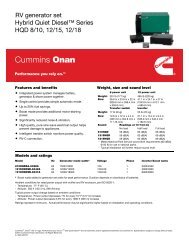Air Brake Manual
Air Brake Manual
Air Brake Manual
Create successful ePaper yourself
Turn your PDF publications into a flip-book with our unique Google optimized e-Paper software.
Quick Release Valve<br />
The application of the brakes in the basic system<br />
was described earlier. In a basic system, when the<br />
driver releases the foot valve, it would be necessary<br />
for the air under pressure in the brake chambers to<br />
return to the foot valve to release the brakes. This<br />
releasing action would be slowed in long wheel<br />
base vehicles because of the longer lines between<br />
the foot valve and the rear brake chambers. To allow<br />
the brakes to release quickly and fully by<br />
discharging the application air near the brake<br />
chambers, a quick release valve (33) may be<br />
installed.<br />
Quick Release Valve<br />
the foot valve. Releasing the foot valve exhausts the<br />
control air to the relay valve, allowing it to cut off the<br />
flow of reservoir air to the rear chambers. This in<br />
turn exhausts the air in the brake chambers by the<br />
quick release feature of the relay valve.<br />
Relay Valve<br />
Relay Valve<br />
The foot valve is usually located closer to the front<br />
wheels than to the rear wheels. The longer the<br />
distance from the foot valve to the rear chambers, the<br />
more time it will take before the rear brakes apply.<br />
This is known as brake lag. To correct this condition<br />
on a long wheel base vehicle, a relay valve (13) is<br />
installed near the rear brake chambers. A larger<br />
diameter pipe is connected between the main<br />
reservoir and the relay valve. The air line from the foot<br />
valve to the relay valve now becomes a “control line.”<br />
(The air in the control line “dead ends” at the relay<br />
valve.) When the foot valve is depressed, the air<br />
pressure in the control line acts on the top section of<br />
the relay valve, relaying reservoir air directly to the<br />
rear brake chambers through the larger diameter pipe.<br />
The pressure of the reservoir air delivered in this way<br />
will be the same as the control pressure delivered by<br />
<strong>Manual</strong> Front <strong>Brake</strong> Limiting Valve<br />
For better steering control on a slippery road surface,<br />
it can be an advantage to reduce the braking effort to<br />
the front wheels. This can be accomplished by<br />
installing a control valve (35) in the cab, and a front<br />
brake limiting valve (36) on the front axle.<br />
The control valve is set in the “normal” position for dry<br />
road surfaces and the front braking application air<br />
pressure is normal. On a slippery road surface, the<br />
control valve (35) is set to the “slippery road” position.<br />
In this position, the control valve will cause the limiting<br />
valve (36) to operate. Applying air pressure to the front<br />
brakes is then reduced to 50 percent of the application<br />
air pressure being delivered to the rear brake<br />
chambers.<br />
<strong>Manual</strong> Front <strong>Brake</strong><br />
Limiting Valve<br />
Service port<br />
From<br />
limiting<br />
valve<br />
To limiting valve<br />
Dash Mounted<br />
Control Valve<br />
Lever<br />
28<br />
Exhaust port<br />
Delivery ports not shown<br />
Service port




